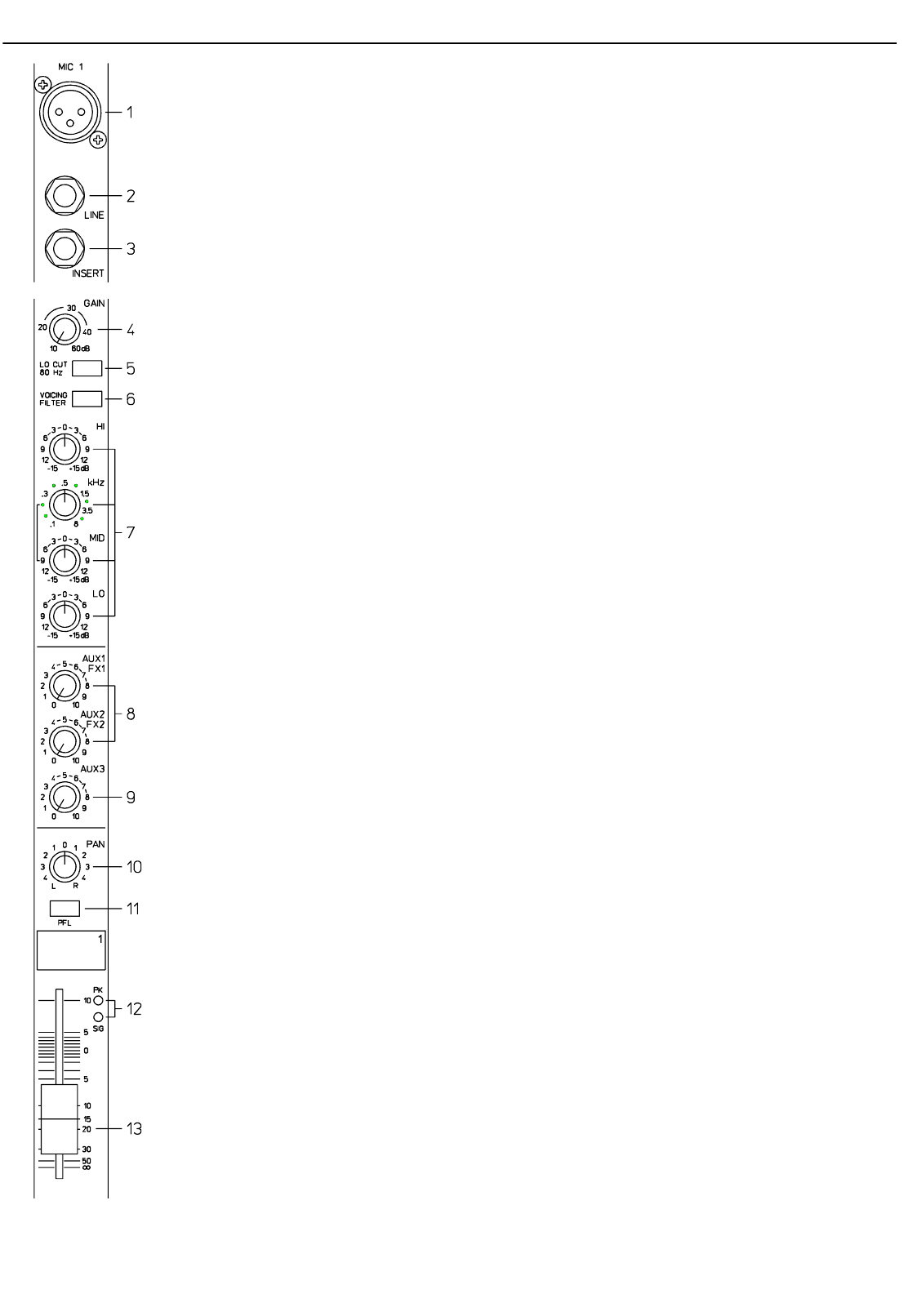
9. AUX 3
The AUX 3 control is primarily meant for the monitor mix. Nevertheless, when the master section’s AUX3 POST
button is pressed, it can also be used as a third FX send bus. In that case, the signal is split post-fader and outputted
via the AUX 3 send jack.
To establish a monitor mix you can choose between two alternatives. The main difference being the point where
the signal is split according to the setting of the AUX3 POST button.
If the AUX3 POST button is not engaged, the signal split is PRE FADER – the setting of the channel faders does
not affect the signal level that is present at the AUX3 rotary controls. Since the monitor mix is not influenced by
the setting of the channel faders, this alternative is primarily used when the main mix and the monitor mix have to
be completely different – the volume of specific musical instruments or vocals needs to be higher or lower or should
not appear at all in the monitor mix. This mode is also preferable when the PSX is operated by a engineer in the
audience area (front of house).
The other alternative should be used when you have to operate the mixer on-stage and still want to have control
over the main mix.
If the AUX3 POST button is engaged (LED is lit), the signal at the AUX3 rotary control is POST FADER – the signal
is split after it passes the channel faders and therefore is affected by their settings. Setting all AUX3 controls to
their center position, the main mix is also present on the monitor bus, giving you the opportunity to control the
volume settings individually from the stage. The overall volume of the monitor mix is set with the AUX3 fader in the
master section. If you are using this option you have to keep in mind that all volume changes made with the channel
faders also appear in the monitor mix, leaving you with a higher risk of acoustical feedback.
To reduce the risk of feedback, you still have the option to adjust the individual send levels via the channels’ AUX3
rotary controls. There is even the possibility to cancel some loud instruments – like the kick drum or the snare
drum, which are in fact already loud enough on-stage – totally from the monitor mix by turning the corresponding
controls all the way to the left.
10. PAN
This control determines the position of the connected sound source within the stereo image. When this control is
set at its center position, the audio signal is fed equally to the left and the right master busses. Through the extensive
PAN section circuitry the essential sound pressure level always stays the same, no matter to what position within
the stereo image the PAN control is set.
11. PFL
Engaging the PFL button (Pre Fader Listening) routes the audio signal of the corresponding channel to the
headphone bus. In this way you can route as many signals as you want to the bus at the same time. The volume
levels of the individual signals are not affected by the channel fader settings – PRE FADER LISTENING. This gives
you the opportunity to set the level or the EQ of a channel without the need to include it in the main mix. The overall
signal of the headphone bus is present at the headphone output.
12. SIGNAL (present) / PEAK indicator
These indicators play a key role during the level adjustment of the input channels, offering visual confirmation of
the actual signal level. They provide the possibility of detecting the risk of overdrive before you would actually hear
the distortion, unlike the mixers of many other manufacturers that either only provide a PEAK indicator or no channel
indicator at all.
As described before, the signal “present” LED should blink in the rhythm of the incoming signal. If this is not the
case, you should increase the gain. If the PEAK LED blinks frequently or lights up constantly, the corresponding
channel is likely to enter clipping and you should turn the gain control a bit to the left. The signal “present” LED
lights at levels –30dB below clipping while the peak LED lights at a level of –6dB below the occurrence of overdrive.
It is also a good idea to watch the indicator during a performance. During performances, some musicians get carried
away by the music and the atmosphere and tend to play their instruments more dynamic than during the rehearsal.
This, of course, can easily lead to channel clipping, resulting in degradation of the sound.
13. VOLUME
The channel faders are used to set the volume of the corresponding channels and to establish an accurately
proportioned mix. The channel faders should be positioned within the range of –5dB to 0dB, leaving you with a
degree of control that allows the precise matching of relatively large differences in the channels’ level settings. The
overall volume is set through the use of the master faders.
Even though the channel faders offer an additional gain of +10dB, we would recommend that you not exceed the
+5dB mark. If the PSX’s main bus gets “overloaded” with too many “high level” input channels, despite its special
negative gain structure, the summing amplifier could be driven into clipping. Once you reach a level where some
channel faders are set above the 0dB marking, we would recommend you lower the setting of each channel fader
by about –5dB and increase the overall output level by elevating the master faders. The proportion of the mix and
the overall volume stay the same while the risk of clipping is prohibited.
INPUT/MONO
7of32


















